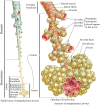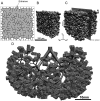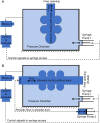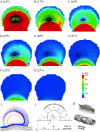Recent advances in the understanding of alveolar flow
- PMID: 35464135
- PMCID: PMC9010052
- DOI: 10.1063/5.0084415
Recent advances in the understanding of alveolar flow
Abstract
Understanding the dynamics of airflow in alveoli and its effect on the behavior of particle transport and deposition is important for understanding lung functions and the cause of many lung diseases. The studies on these areas have drawn substantial attention over the last few decades. This Review discusses the recent progress in the investigation of behavior of airflow in alveoli. The information obtained from studies on the structure of the lung airway tree and alveolar topology is provided first. The current research progress on the modeling of alveoli is then reviewed. The alveolar cell parameters at different generation of branches, issues to model real alveolar flow, and the current numerical and experimental approaches are discussed. The findings on flow behavior, in particular, flow patterns and the mechanism of chaotic flow generation in the alveoli are reviewed next. The different flow patterns under different geometrical and flow conditions are discussed. Finally, developments on microfluidic devices such as lung-on-a-chip devices are reviewed. The issues of current devices are discussed.
© 2022 Author(s).
Figures









Similar articles
-
Modeling Airflow and Particle Deposition in a Human Acinar Region.Comput Math Methods Med. 2019 Jan 14;2019:5952941. doi: 10.1155/2019/5952941. eCollection 2019. Comput Math Methods Med. 2019. PMID: 30755779 Free PMC article.
-
Microflow in a rhythmically expanding alveolar chip with dynamic similarity.Lab Chip. 2020 Jun 30;20(13):2394-2402. doi: 10.1039/c9lc01273g. Lab Chip. 2020. PMID: 32510532
-
Effects of airway deformation and alveolar pores on particle deposition in the lungs.Sci Total Environ. 2022 Jul 20;831:154931. doi: 10.1016/j.scitotenv.2022.154931. Epub 2022 Mar 30. Sci Total Environ. 2022. PMID: 35364181
-
A Review of Respiratory Anatomical Development, Air Flow Characterization and Particle Deposition.Int J Environ Res Public Health. 2020 Jan 7;17(2):380. doi: 10.3390/ijerph17020380. Int J Environ Res Public Health. 2020. PMID: 31935991 Free PMC article. Review.
-
Modeling techniques for inhaled particle deposition: the state of the art.J Aerosol Med. 1996;9(3):369-88. doi: 10.1089/jam.1996.9.369. J Aerosol Med. 1996. PMID: 10163662 Review.
Cited by
-
Molecular Impact of Conventional and Electronic Cigarettes on Pulmonary Surfactant.Int J Mol Sci. 2023 Jul 20;24(14):11702. doi: 10.3390/ijms241411702. Int J Mol Sci. 2023. PMID: 37511463 Free PMC article. Review.
-
Hypertonic treatment of acute respiratory distress syndrome.Front Bioeng Biotechnol. 2023 Oct 23;11:1250312. doi: 10.3389/fbioe.2023.1250312. eCollection 2023. Front Bioeng Biotechnol. 2023. PMID: 37936822 Free PMC article.
-
Physiological Modeling of the Vascularized Human Lung Organoid.Am J Respir Cell Mol Biol. 2025 Apr;72(4):354-363. doi: 10.1165/rcmb.2024-0413MA. Am J Respir Cell Mol Biol. 2025. PMID: 39514019
-
Validated respiratory drug deposition predictions from 2D and 3D medical images with statistical shape models and convolutional neural networks.PLoS One. 2024 Jan 26;19(1):e0297437. doi: 10.1371/journal.pone.0297437. eCollection 2024. PLoS One. 2024. PMID: 38277381 Free PMC article.
References
-
- Chuang H.-C., in Oxidative Stress in Lung Diseases, edited by Chakraborti S., Chakraborti T., Das S. K., and Chattopadhyay D. (Springer, Singapore, 2019), Vol. 1, pp. 293–307.
Publication types
LinkOut - more resources
Full Text Sources
